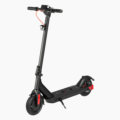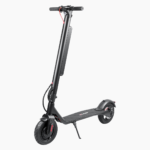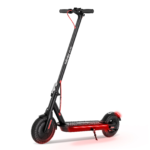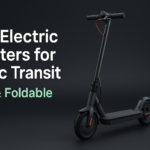- Home
- Scooters
- Electric Scooters
- TurboAnt M10 Pro
TurboAnt M10 Pro
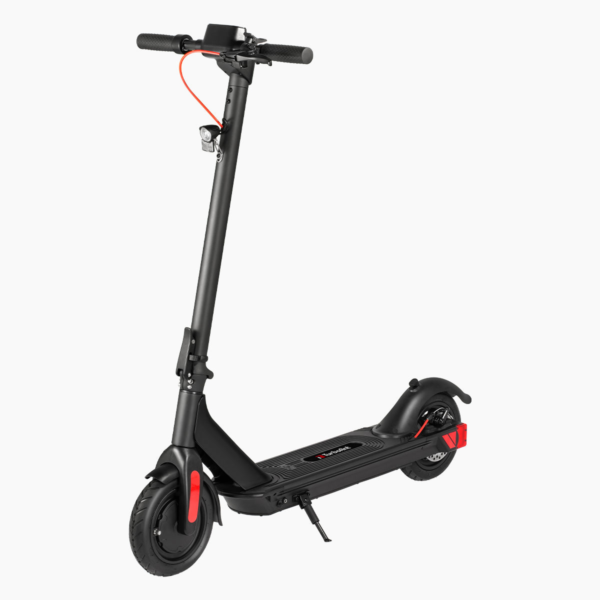

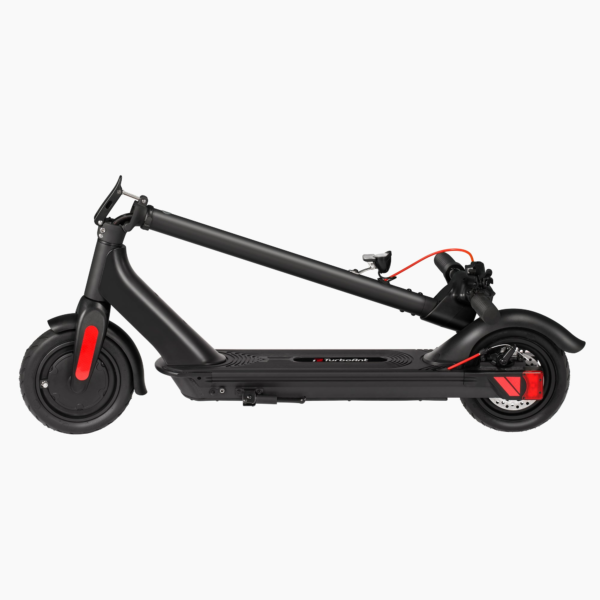
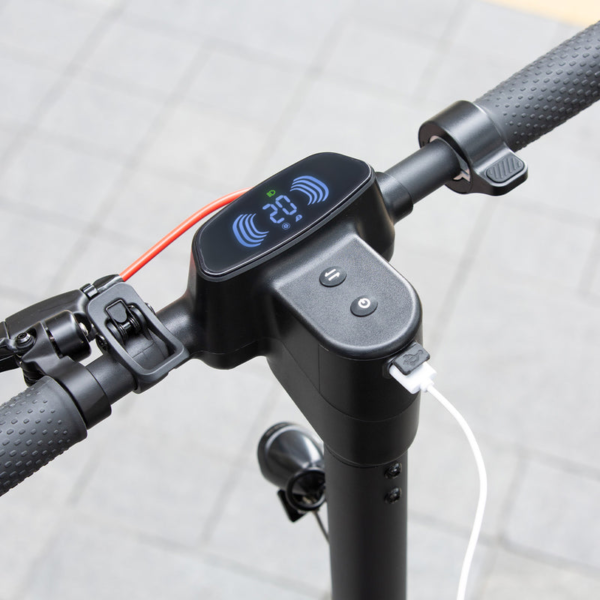
- Battery Range: 30 miles (48 km)
- Top Speed: 20 mph (32 km/h)
- Motor Power: 350 W
- Weight Capacity: 220 lb (100 kg)
- Charging Time: ~5–6 h
- Scooter Weight: Not specified
PROS
- Longer 30-mile (48 km) range
- 10″ pneumatic tires
- Rear disc + electronic brake
- Stable rear-wheel drive
- Simple controls
CONS
- No suspension
- Heavier than the M10
- No Bluetooth app
- Some specs not officially published
Table of contents
- What Is the TurboAnt M10 Pro?
- How the TurboAnt M10 Pro Works
- Key Specifications
- Design & Build Quality
- Performance Fundamentals
- Battery, Range & Efficiency
- Ride Quality & Comfort
- Braking & Safety Features
- Portability & Daily Usability
- Maintenance & Care
- Weather & Seasonal Considerations
- TurboAnt M10 Pro vs Alternatives
- Who the TurboAnt M10 Pro Is (and Isn’t) For
- FAQs
- Glossary (Electric Scooter Essentials)
- Final Thoughts
If you want a simple, dependable commuter that’s easy to carry and even easier to ride, the TurboAnt M10 Pro is built for you. Moreover, it’s a compact, entry-level scooter with real-world range, straightforward controls, and low-stress upkeep. Because it pairs a 350 W front hub motor with 8.5-inch pneumatic tires and a practical 36 V, 10.4 Ah battery, it suits students, office commuters, and last-mile riders who prioritize comfort and predictability over flash. Its approachable character also echoes the friendly manners of the TurboAnt M10.
What Is the TurboAnt M10 Pro?
The TurboAnt M10 Pro is a lightweight urban electric scooter designed for daily transportation and short to medium city trips. Additionally, it keeps the layout familiar—front hub motor, rear disc brake with electronic assist, and an under-deck battery—so new riders can hop on and go without a learning curve. In plain terms, it’s a “grab-and-ride” commuter: modest power, steady handling, and a portable fold that fits apartments, car trunks, and office corners.
While the design is conservative, the M10 Pro adds a few thoughtful bonuses. For instance, it includes cruise control for relaxed cruising, an LED display that stays readable in sun, and a USB phone-charging port so your navigation won’t die mid-ride. Finally, its IP54 water-resistance rating means it shrugs off light splashes and dust; however, you’ll still treat rain-riding with care, as you would with any commuter scooter.
How the TurboAnt M10 Pro Works
Motor & Controller. A 350 W brushless front hub motor handles propulsion. Consequently, you’ll feel a gentle shove off the line rather than a snap. That’s by design. The controller softens initial current so beginners get predictable starts and smoother throttle ramps, especially when navigating tight paths or mixing with bike-lane traffic.
Battery & Power Delivery. The under-deck 36 V, 10.4 Ah (≈374 Wh) lithium-ion battery feeds the motor through an optimized controller. Because the pack sits low, it improves stability—much like a low center of gravity in a city bicycle. Furthermore, regenerative braking in the front motor lightly recovers energy during deceleration.
Throttle & Modes. A thumb throttle manages speed with two riding modes: Mode 1 (~12 mph / 19 km/h) for longer range and low-stress cruising, and Mode 2 (~20 mph / 32 km/h) when you need to keep up with fast bike lanes. In addition, cruise control can automatically hold steady speed after a brief, consistent throttle input—handy on long straight sections.
Brakes. A rear mechanical disc brake teams up with front electronic braking (regen). Squeeze the single lever and both systems engage. As a result, the regen system helps settle the front end and reduces the chance of a front-wheel lockup; meanwhile, the rear disc provides the bite you can feel at the lever.
Key Specifications
Importantly, these specifications reflect the manufacturer’s published data for the M10 Pro.
General
| Item | Detail |
|---|---|
| Intended Use | Urban commuting and last-mile trips |
| Water Resistance | IP54 (resists light splashes and dust) |
| Maximum Rider Weight | 220 lb (100 kg) |
| Display | LED panel (speed, battery, mode) |
| Bell | Included |
Performance & Power
| Item | Detail |
|---|---|
| Motor | 350 W front hub (brushless) |
| Top Speed | 20 mph (32 km/h) |
| Hill Climb | Up to 15% grades (rider/terrain dependent) |
| Riding Modes | Mode 1 (~12 mph / 19 km/h), Mode 2 (~20 mph / 32 km/h) |
| Braking System | Rear disc + front electronic (regen) |
| Braking Distance | ~16.4 ft (5 m) on dry pavement |
| Tires | 8.5-in pneumatic (inner tubes), front & rear |
Battery, Charging & Electrical
| Item | Detail |
|---|---|
| Battery | 36 V, 10.4 Ah (≈374 Wh) lithium-ion |
| Placement | Under-deck (low center of gravity) |
| Charging Time | ~6 hours from low state |
| Charger Input | AC 100–240 V, 50/60 Hz |
| Charging Output | 42 V DC, 2 A |
| USB Port | Phone charging, DC 5 V / 1 A |
Build & Dimensions
| Item | Detail |
|---|---|
| Net Weight | 36.37 lb (16.5 kg) |
| Unfolded (L × W × H) | 44.49 × 19.69 × 45.87 in (1130 × 500 × 1165 mm) |
| Folded (L × W × H) | 44.49 × 19.69 × 20.48 in (1130 × 500 × 520 mm) |
| Handlebar Width | 20 in (50 cm) |
| Deck Length × Width | 17.7 × 6.3 in (45 × 16 cm) |
| Ground Clearance | 3.15 in (80 mm) |
| Frame | Aluminum alloy |
Safety & Control
| Item | Detail |
|---|---|
| Headlight | 1.5 W white LED (adjustable) |
| Taillight | Red LED (brake-activated flash) |
| Reflectivity | Integrated lighting; add passive reflectors as needed |
| Bell | Yes |
| Kickstand | Yes |
Features & Extras
| Item | Detail |
|---|---|
| Cruise Control | Yes (auto-engage after steady throttle) |
| Hidden Wiring | Cleaner look, fewer snag points |
| Anti-Glare Display | Readable in daylight |
| Two Modes | Efficiency vs. speed focus |
| USB Power | Keeps your phone topped up on the go |
Warranty & Compliance
| Item | Detail |
|---|---|
| Warranty | 12-month limited coverage (region-specific terms) |
| Charger Compatibility | 100–240 V global input |
| Environmental | IP54 ingress protection |
| Regulatory Notes | Rider is responsible for following local micromobility laws |
Design & Build Quality
The M10 Pro follows a proven city-scooter silhouette: straight deck, round stem, and a one-step folding latch near the deck hinge. Consequently, the aluminum frame feels stiff for its weight class, and the hidden wiring keeps the cockpit tidy. Rubber grips and a thumb throttle flank the compact LED display; crucially, the cockpit remains uncluttered, so you won’t hunt for controls while rolling.
Because the battery is under the deck, the scooter rides with a planted feel. You notice that most when cornering or crossing imperfect pavement—the deck doesn’t skitter, and the steering stays neutral. Additionally, the 6.3-inch deck is wide enough to place your lead foot at a slight angle and rest your rear foot comfortably. That stance matters on longer commutes.
Fit-and-finish is what you expect in this bracket: clean welds, a matte finish that hides scuffs, and a folding joint that clicks home with a reassuring sound. Moreover, the latch is simple, which is good; fewer parts mean less to adjust over time.
Performance Fundamentals
Acceleration feel. Off the line, the TurboAnt M10 Pro is gentle. Therefore, you’ll kick to start, roll on the thumb throttle, and feel the scooter build speed progressively. That mellow curve helps new riders manage balance and braking without surprises. After ~10–12 mph, it keeps pulling until it steadies around 20 mph (32 km/h) in Mode 2 on level ground.
Cruising stability. The 8.5-inch pneumatic tires provide more give than solid honeycombs, so they soak up chatter from expansion joints and patched asphalt. Furthermore, the steering feels calm at typical bike-lane speeds. Because the stem is relatively short and the handlebar is 20 inches (50 cm) wide, inputs are precise but never twitchy.
Hill behavior. On 7–10% grades, the motor slows but keeps moving if you carry a bit of momentum. Standing tall and keeping your weight centered helps the controller maintain current without bogging. On steeper bursts near 15%, you’ll notice the scooter’s commuter tuning—light riders fare better, and a short run-up helps. Even so, for a mostly flat cityscape, this capability is enough.
Battery, Range & Efficiency
The heart of the system is a 36 V, 10.4 Ah (≈374 Wh) pack. On paper, the scooter quotes up to 30 miles (48 km) at conservative speeds in Mode 1. In practice, range depends on rider weight, stop density, temperature, wind, and elevation. As a rule of thumb:
- Light riders (≤150 lb / 68 kg) on mostly flat routes can approach the high teens to low 20s (miles) in faster mode, and significantly more in the efficient mode.
- Average riders (160–190 lb / 73–86 kg) typically see mid-teens to high teens in stop-and-go Mode 2, with efficiency mode extending that notably.
- Heavier riders (200+ lb / 91+ kg) or hilly routes reduce range further, especially in cold weather.
Because the pack sits low, the scooter wastes less energy correcting balance after bumps, which subtly helps efficiency over rougher urban surfaces. Additionally, charging takes about six hours from a low state with the included 42 V/2 A charger. To keep the battery healthy, avoid storing completely empty or fully topped for weeks. Instead, store around 50–60% when the scooter rests for a while, and top up monthly if it sits.
Ride Quality & Comfort
Tires. The 8.5-inch tubed pneumatic tires are the star of the comfort story. Consequently, they deform over cracks and rough patches that would rattle solid tires. Keep them properly inflated and they’ll protect rims and bearings while rolling more efficiently than under-inflated rubber.
Suspension. There’s no mechanical suspension, but the frame is tuned to stay quiet. Therefore, the tire sidewalls supply most of the compliance. As a result, the scooter rides best at 12–18 mph on imperfect streets, where the tires can do their work without sharp impacts.
Ergonomics. The deck length (17.7 in / 45 cm) supports an angled stance. Meanwhile, the LED display is bright enough to read at noon, and the throttle throw is short. In addition, the bell is reach-friendly, which helps with bike-path etiquette.
Stem flex. Light commuters sometimes suffer from vague steering under braking. Here, the M10 Pro’s stem feels adequately stiff. You may sense a faint flex if you brake hard while leaning, but it’s minimal and typical for this class. Consequently, the scooter remains confidence-inspiring for new riders.
Braking & Safety Features
The rear disc + front electronic combo is confidence-building for new riders. Pull the lever halfway and the electronic front brake leans the scooter into deceleration without drama. Past half-pull, the rear disc adds a firm bite. On clean, dry pavement, stopping distances around 16–20 ft (≈5–6 m) from 15 mph are typical for well-maintained brakes and tires in this range.
The 1.5 W headlight is height-adjustable, so point it slightly down to light the road without dazzling oncoming traffic. Likewise, the tail light brightens under braking and sits high enough to be visible. Because you may ride at dusk, consider adding passive reflectors on your helmet or backpack for extra visibility.
The IP54 rating is about splash protection, not submersion. Therefore, puddles and light mist are one thing; heavy rain is another. If streets are soaked, slow down and lengthen your following distance—wet braking takes longer. Afterward, dry the scooter and store it indoors to protect bearings and connectors.
Portability & Daily Usability
At 36.37 lb (16.5 kg), the M10 Pro is manageable for short stair carries and train platforms. Moreover, the folded size—44.49 × 19.69 × 20.48 in (1130 × 500 × 520 mm)—is long but slim, so it slides into trunk spaces and tight closets. The one-step latch takes seconds once you learn the sequence: lower the stem, catch the clip, and lift from the deck or stem.
Daily routines are simple. Unfold, power on, and choose your mode. Additionally, the USB charging port (DC 5 V / 1 A) is surprisingly useful when navigation drains your phone. Because the scooter stands securely on its kickstand, quick errands are painless. For security, treat it like a bicycle: lock the frame to an anchored rack and avoid overnight outdoor storage.
Maintenance & Care
A few small habits keep the TurboAnt M10 Pro running smoothly:
- Tire pressure. Check weekly. Under-inflated tires increase flats and sap range. Therefore, inflate to the sidewall recommendation, adjusting slightly for comfort.
- Brake upkeep. Inspect the rear disc caliper and cable tension monthly. If the lever travel grows long, a small tension tweak restores bite.
- Bolts & latch. Every couple of weeks, check stem clamp hardware, axle nuts, and fender screws. Consequently, a quick once-over prevents rattles.
- Battery habits. Don’t store empty. If you pause riding for a month, leave the battery around half charge and top up monthly.
- Firmware/app. If an app update becomes available in your region, apply it only when the scooter is fully charged and stationary.
- Cleaning. Wipe the deck and wheels after wet rides. Avoid pressure washers; a damp cloth is safer for bearings and electronics.
Simple schedule (starter guide).
- Weekly: Tires & lights.
- Biweekly: Brake feel, latch check.
- Monthly: Fasteners, cable inspection, deep clean.
- Quarterly: Full bolt check, brake pad wear check, tire inspection for embedded debris.
Weather & Seasonal Considerations
Rain. With IP54, the scooter handles light spray, but wet braking distances increase. Consequently, reduce speed, brake earlier, and avoid painted crosswalks and metal grates—they’re slick. Dry the scooter after rides and store indoors to protect bearings and connectors.
Heat. Batteries dislike sustained heat. If you park outside, shade the scooter. Furthermore, after a long hot ride, let it rest a few minutes before charging.
Cold. Range drops in low temperatures because chemistry slows. Expect a noticeable reduction below 40°F (4°C). Nevertheless, warming the scooter indoors before charging helps.
Storage. If you won’t ride for weeks, clean, dry, and store around 50–60% charge. Then, check monthly and top up as needed.
TurboAnt M10 Pro vs Alternatives
Entry-level commuters. Against other budget commuters, the M10 Pro leans into comfort and range rather than brute torque. Many peers match the listed top speed; however, fewer combine pneumatic tires with a calm controller and practical USB power. If you want a stress-free first scooter for city lanes, the M10 Pro stands out. Meanwhile, riders who prefer a stem-mounted, removable battery format may consider the TurboAnt X7 Max as a different take on portability and day-to-day convenience.
Mid-performance commuters. Stepping up in price often adds larger batteries, dual mechanical brakes, or rear motors with punchier launches. Those scooters typically weigh more and fold a bit bulkier. Therefore, if you need stronger hill climbing, you’ll likely graduate to that tier. In that case, you trade portability for power and additional specifications.
Off-road or heavy-duty models. Off-road scooters bring wider tires, suspension, and heavyweight frames. They crush dirt paths but are overkill for elevators and rail platforms. Unless your route includes rough trails, the added mass and cost won’t help daily commuting.
Multi-modal travel. For riders mixing bus, subway, or rideshare, the M10 Pro’s manageable mass and quick fold make life easier. Accordingly, that portability is precisely where it excels relative to bigger, faster machines.
Who the TurboAnt M10 Pro Is (and Isn’t) For
Best for:
- Daily commuters who value predictable handling, clear lighting, and a real-world range that makes round-trips feasible.
- Students who need a reliable way to cross campus quickly and quietly.
- Last-mile riders connecting rail stops to offices or apartments.
- New owners who want straightforward upkeep and widely available inner tubes and brake pads.
Not ideal for:
- Very steep neighborhoods. Consistent grades over ~10% can sap speed.
- Speed chasers. If you’re looking for rapid launches or 25+ mph cruising, you’ll want a higher-power class.
- Frequent heavy rain riders. Light splashes are fine; however, routine storm commuting isn’t what IP54 is for.
FAQs
1) How fast does it go?
Up to 20 mph (32 km/h) on level ground in Mode 2, with a calm throttle curve that helps new riders feel in control.
2) What range can I expect day to day?
The listed maximum is 30 miles (48 km). In everyday mixed riding, mid-teens to low-20s (miles) is typical for many riders, depending on weight, stops, and terrain. Additionally, colder weather reduces range.
3) Does it have cruise control?
Yes. After holding a steady throttle for a short period, cruise sets automatically and holds that speed until you brake or nudge the throttle. Consequently, hand fatigue on long straight sections drops.
4) Can I ride in the rain?
It’s IP54. Light splashes are fine, but slow down on wet pavement and avoid heavy rain. After rides, dry the scooter to protect components.
5) What tires does it use, and can I fix a flat?
8.5-inch tubed pneumatic tires front and rear. Flats are fixable with standard tubes; therefore, carry levers and a small pump for longer trips.
6) How does the braking feel?
The single lever blends front electronic regen with a rear disc. Initial lever pull feels smooth; squeeze harder for stronger stopping. Moreover, practice a few controlled stops in a quiet lot to learn the bite point.
7) Where can I find a quick “TurboAnt M10 Pro overview”?
Right here. You’ve got the essentials: motor, battery, range, tires, brakes, and real-world usage tips in one place.
Glossary (Electric Scooter Essentials)
- Ah (Amp-hour): Battery capacity measure. Higher Ah usually means longer range.
- Wh (Watt-hour): Battery energy (volts × amp-hours). Consequently, it’s better for comparing range potential across scooters.
- Controller: The electronic “brain” that meters battery power to the motor for smooth acceleration and braking.
- Regen (Regenerative Braking): Uses the motor as a generator to slow the scooter and recover a small amount of energy.
- Stem Flex: Slight bending in the steering tube during riding or braking; too much can feel vague.
- IP Rating: Ingress Protection. IP54 means splash-resistant and dust-resistant, not waterproof.
- Hub Motor: Motor integrated into the wheel; simple, quiet, and low maintenance.
- Pneumatic Tire: Air-filled tire that cushions bumps and improves grip compared with solid designs.
- Kick-to-Start: Requires a brief push before the motor engages; therefore, it reduces accidental throttle starts.
- Torque: Twisting force that moves you off the line and up hills.
- Mechanical Disc Brake: Cable-driven brake that squeezes a rotor to slow the wheel.
- LED Headlight/Taillight: Efficient lights for visibility; upgrade beam pattern if you ride at night often.
- Cruise Control: Electronic feature that maintains current speed until canceled.
- Riding Modes: Preset speed/acceleration profiles to prioritize range or pace.
- Ground Clearance: Space between deck and ground; thus, it helps with curbs and uneven surfaces.
Final Thoughts
The TurboAnt M10 Pro doesn’t reinvent the category—and that’s its strength. Instead, it focuses on what actually matters to daily riders: stable manners, comfortable tires, simple brakes, and a battery that gets you there and back. Add a clean fold and a readable display, and you’ve got a practical commuter that’s easy to live with. If your route is mostly flat, your storage space is tight, and your priority is a calm, confidence-building ride, this scooter checks the right boxes. In short, it’s a sensible, low-drama way to travel.
Specifications
General
| Model The Model specifies the exact version or name of the scooter. It helps identify its unique design, features, and specifications within the manufacturer’s product line. Knowing the model makes it easier to compare options, find compatible accessories, or look up support information. | M10 Pro |
| Brand The Brand identifies the manufacturer or company that designs and produces the scooter. A trusted brand is a sign of quality, reliability, and good customer support. Well-known brands often have higher standards for safety, performance, and after-sales service, giving you more confidence in your purchase. | TurboAnt |
| Release Date The Release Date indicates when the scooter model was officially launched on the market. This helps you know how current the design, technology, and features are. A newer release date often means updated components, improved performance, and the latest safety or smart features. | 17 November 2025 |
| Recommended Age Recommended Age indicates the minimum age range that the scooter is designed for, based on safety, size, and ease of use. Following the recommended age helps ensure that riders can handle the scooter’s speed, weight, and controls comfortably and safely. Always check local laws and use protective gear, especially for younger riders. | 16+ |
Performance & Power
| Motor Power (Wattage) What it means: The motor power, measured in watts (W), shows how strong the scooter’s electric motor is. Why it matters: Higher wattage usually means better acceleration, more torque, and improved performance on hills or rough terrain. For example, a 250W motor is good for flat city roads and light riders, while a 500W or 1000W motor provides more power for faster speeds or climbing steep inclines. | 350 W rear hub motor |
| Top Speed The Top Speed indicates the maximum speed that the scooter can reach under optimal conditions. It’s usually measured on level ground with a fully charged battery and an average rider weight. A higher top speed allows you to travel longer distances faster, but always ensure you ride within legal speed limits and your personal comfort zone for safety. | 20 mph (32 km/h) |
| Battery Capacity Battery Capacity refers to the total amount of energy the scooter’s battery can store, usually measured in ampere-hours (Ah) or watt-hours (Wh). A higher battery capacity means you can ride longer distances on a single charge, reducing the need for frequent recharging. Keep in mind that actual range can vary depending on rider weight, terrain, speed, and weather conditions. | 36 V 10 Ah (360 Wh) |
| Estimated Range per Charge The Estimated Range per Charge indicates the average distance the scooter can travel on a single full battery charge. This range is calculated under optimal conditions, such as flat terrain, moderate speed, and average rider weight. Real-world range may vary depending on riding style, terrain, weather, and load. A longer range means fewer recharges and greater freedom for longer trips. | 30 miles (48 km) |
| Hill Climb Ability Hill Climb Ability describes the maximum incline or slope that the scooter can handle while maintaining stable performance. It’s typically expressed as a percentage or in degrees. A higher hill climb rating means the scooter can tackle steeper hills without losing too much speed or power. Actual climbing performance may vary based on rider weight, battery charge, and terrain conditions. | 15% |
| Drive System The Drive System refers to how power from the motor is delivered to the wheels. Electric scooters typically use either a hub motor (directly integrated into the wheel) or a chain/belt drive system. A high-quality drive system ensures smooth acceleration, efficient power transfer, and low maintenance. The choice of drive system affects performance, noise level, and overall ride experience. | Rear hub (RWD) |
Charging & Electrical
| Charging Time Charging Time indicates how long it takes to fully recharge the scooter’s battery from empty to 100% using the standard charger provided. Faster charging means less downtime and more time on the road. Actual charging time may vary slightly depending on battery capacity, charger output, and environmental conditions. | Approx. 5–6 hours |
| Battery Type Battery Type refers to the specific technology used in the scooter’s battery, which affects performance, lifespan, weight, and charging time. Most modern electric scooters use high-quality lithium-ion (Li-ion) batteries because they offer a good balance of energy density, durability, and low maintenance. A reliable battery type ensures consistent power delivery and longer riding ranges. | Lithium-ion pack with Smart BMS |
| Removable Battery A Removable Battery means the battery pack can be easily detached from the scooter for convenient charging and replacement. This feature allows you to charge the battery separately, swap it with a spare for extended range, or securely store it indoors in extreme weather. Removable batteries add flexibility and make it easier to keep your scooter powered up wherever you are. | Non-removable internal battery (fixed pack) |
| Regenerative Braking Regenerative Braking is an energy-saving feature that converts some of the energy normally lost during braking back into battery power. When you slow down or brake, the motor works in reverse to generate electricity, which helps extend the scooter’s range and improves overall efficiency. This system also reduces wear on traditional brake components, leading to lower maintenance over time. | Yes (via electronic brake) |
| Lighting Lighting refers to the built-in front and rear lights that enhance visibility and safety when riding in low-light conditions or at night. Good lighting helps you see the road ahead and ensures that other road users can see you. Many scooters include LED headlights, taillights, and sometimes brake lights or side reflectors for added safety and compliance with local traffic regulations. | LED headlight + rear LED/brake + reflectors |
Build & Dimensions
| Scooter Weight Scooter Weight refers to the total weight of the scooter when fully assembled, including the battery. This affects how easy it is to carry, lift, and store the scooter when not in use. A lighter scooter is more portable and convenient for commuting, especially if you need to carry it upstairs or onto public transport. Keep in mind that a sturdy frame and quality components may add to the weight but also contribute to better durability and ride stability. | Not specified |
| Maximum Rider Weight Maximum Rider Weight indicates the highest rider weight that the scooter is designed to safely support while maintaining optimal performance and stability. Staying within this limit helps ensure reliable acceleration, braking, and climbing ability, and it protects the frame, suspension, and motor from excessive strain. Exceeding the recommended limit may reduce performance and increase wear on components. | 220 lb (100 kg) |
| Deck Size Deck Size refers to the dimensions of the scooter’s standing platform. A wider and longer deck provides more foot space, allowing you to stand comfortably and adjust your stance while riding. A well-sized deck improves balance and stability, especially on longer rides or at higher speeds. Compact decks, on the other hand, help keep the scooter lightweight and portable. | Reinforced folding stem; low deck |
| Handlebar Height Handlebar Height refers to the distance from the deck to the handlebars, which affects your riding posture and comfort. An appropriate handlebar height helps you maintain good balance, reduces strain on your back and arms, and makes steering more comfortable. Some scooters have adjustable handlebars to fit riders of different heights, while others have a fixed height for a streamlined design. | Fixed |
| Folding Mechanism The Folding Mechanism describes how easily and securely the scooter can be folded for carrying and storage. A well-designed folding system lets you quickly collapse the scooter into a compact size, making it convenient to transport on public transit, store under a desk, or fit into a car trunk. Look for sturdy latches and safety locks to ensure the scooter stays firmly in place when folded or unfolded. | Quick-fold latch |
| Dimensions Folded Dimensions indicate the size of the scooter when it’s fully folded. This measurement shows how much space the scooter will take up when stored or carried, making it easier to check if it will fit in your car trunk, under a desk, or in a closet. Compact folded dimensions are ideal for commuters who need to bring their scooter on public transport or store it in tight spaces. | Folded: Not specified; Unfolded: Not specified |
| Material Material refers to the primary construction materials used for the scooter’s frame and key components. High-quality materials like aircraft-grade aluminum, reinforced steel, or durable composites provide strength, stability, and a lighter overall weight. A sturdy material ensures the scooter can handle daily wear and tear while maintaining safety and performance. | Aluminum alloy |
Safety & Control
| Brake Type(s) Brake Type(s) describe the braking systems the scooter uses to help you slow down or stop safely. Common brake types include mechanical brakes (like drum or disc brakes), electronic brakes, and foot brakes. Many scooters combine multiple braking systems for added safety and shorter stopping distances. The type and quality of brakes affect your control, especially when riding at higher speeds or on slopes. | Front electronic + rear mechanical disc |
| Suspension Suspension refers to the system that absorbs shocks and vibrations while riding, providing a smoother and more comfortable ride over uneven or rough surfaces. Scooters may have front suspension, rear suspension, or dual suspension for better shock absorption and stability. Good suspension helps reduce rider fatigue and improves control, especially when riding on bumpy roads or off-road paths. | None |
| Tire Type Tire Type refers to the kind of tires the scooter uses, which directly affects ride comfort, traction, and maintenance. Common types include solid (airless) tires, pneumatic (air-filled) tires, or hybrid options. Pneumatic tires offer better shock absorption and a smoother ride on rough surfaces, while solid tires are puncture-proof and require less upkeep. The right tire type helps ensure safe handling and a comfortable ride in different conditions. | 10″ pneumatic street tires |
| Tire Size Tire Size indicates the diameter and width of the scooter’s tires, which affect ride comfort, stability, and how well the scooter handles different terrains. Larger tires generally offer better shock absorption and a smoother ride over bumps and rough surfaces, while smaller tires keep the scooter lighter and more portable. Choosing the right tire size helps ensure a balance between agility and comfort. | 10-inch |
| Kickstand The Kickstand is a built-in stand that allows you to park your scooter upright when it’s not in use. A sturdy kickstand keeps the scooter stable and prevents it from tipping over, protecting it from scratches and damage. It also makes storing and accessing your scooter more convenient, whether you’re at home, work, or on the go. | Side kickstand |
| Water Resistance Rating Water Resistance Rating indicates how well the scooter is protected against water and moisture, usually shown as an IP (Ingress Protection) rating. This rating helps you understand whether the scooter can handle light rain, splashes, or wet roads without damage. While most scooters are not fully waterproof, a good water resistance rating adds peace of mind when riding in changing weather conditions. Always avoid deep puddles or submerging the scooter to protect its electrical components. | IPX4 |
Features & Extras
| Display/Console The Display (or Console) shows important real-time information about your ride, helping you monitor your scooter’s status at a glance. Typical displays show speed, battery level, distance traveled, and riding mode. Some models also include additional features like Bluetooth connectivity, app integration, or backlighting for better visibility at night. A clear and easy-to-read display enhances safety and convenience on every trip. | LED display (speed, battery, mode) |
| Ride Modes Ride Modes refer to the different speed and power settings you can choose to match your riding style or road conditions. Common modes include eco for maximum range and energy efficiency, standard for everyday balance, and sport or turbo for higher speed and stronger acceleration. Switching between ride modes allows you to customize performance, conserve battery, and ride safely in various environments. | Eco/Drive/Sport (3 modes) |
| Smart App Connectivity Smart App Connectivity lets you pair your scooter with a dedicated mobile app via Bluetooth. Using the app, you can monitor real-time ride stats like speed, battery level, and range, adjust settings such as ride modes or cruise control, lock the scooter for added security, and sometimes receive firmware updates. This feature adds convenience and allows you to personalize your riding experience right from your smartphone. | No app |
| Anti-Theft System The Anti-Theft System helps protect your scooter from unauthorized use or theft. This feature can include built-in alarms, electronic motor locks, GPS tracking, or remote locking through a mobile app. A good anti-theft system provides peace of mind when parking your scooter in public spaces, adding an extra layer of security to safeguard your investment. | Not specified |
| Cruise Control Cruise Control allows you to maintain a steady speed without continuously holding the throttle. This feature makes longer rides more comfortable by reducing hand fatigue and providing a smoother, more relaxed riding experience — especially on flat, open roads or bike lanes. For safety, cruise control can usually be easily activated or deactivated while riding. | Yes (cruise control) |
| Accessories Included Accessories Included lists the additional items that come with the scooter to enhance your riding experience and convenience. Common accessories may include a charger, kickstand, bell, lights, phone holder, or carrying strap. These extras add value by making your scooter safer, easier to use, and ready to ride straight out of the box. | Scooter, charger (42 V / 2 A), tools, manual |
Warranty & Compliance
| Warranty Period The Warranty Period indicates how long the manufacturer guarantees the scooter against defects in materials and workmanship under normal use. A good warranty provides peace of mind, showing the brand’s confidence in its product quality. Always check what parts are covered, such as the frame, battery, and motor, and follow the maintenance guidelines to keep your warranty valid. | 12 months (region-dependent) |
| Certifications Certifications confirm that the scooter meets specific safety, quality, and environmental standards set by recognized organizations or regulatory bodies. Common certifications may include CE, RoHS, UL, or other local compliance marks, depending on your region. These certifications ensure that the scooter is manufactured to high standards and is safe and legal to use in your country. | Local micromobility compliance |



